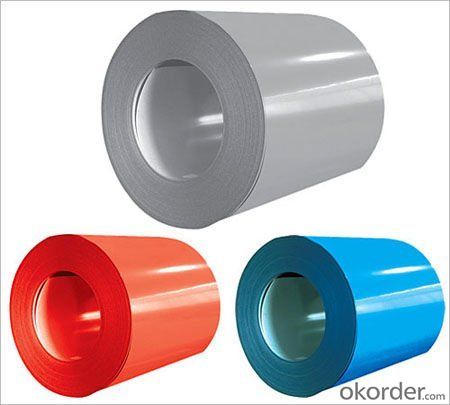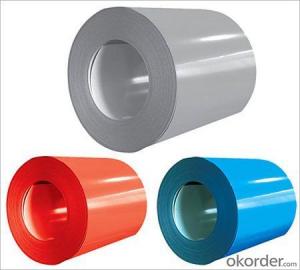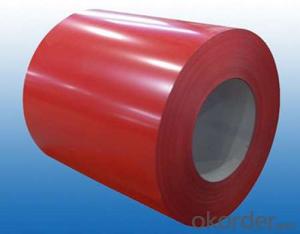Prepainted Galvanized steel Coil for Every Sizes
- Loading Port:
- China main port
- Payment Terms:
- TT OR LC
- Min Order Qty:
- 25 m.t.
- Supply Capability:
- 1 m.t./month
OKorder Service Pledge
OKorder Financial Service
You Might Also Like
1.Structure of Prepainted Galvanized steel Coil
With Gi as base metal, after pretreatmet (degrease and chemical treatment) and liquid dope with several Layers of color, then after firing and cooling, finally the plate steel is called pre-painted galvanized steel ( PPGI) .Pre-painted galvanized steel is good capable of decoration ,molding, corrosion resistance
2.Main Features of Pre-painted Galvanized steel Coil
The hot dip galvalume steel is a kind of coated steel. With the cold rolled steel of different strength and thickness as substrate, it is produced through applying Al-Zn coat on both faces by hot dip process. In its coating, Al accounts for about 55%, Si 1.6%, while the remaining is Zn. It enjoys both the physical protective feature and durability of Al and the electrochemical protective property of Zn. And its surface has bright silver color and regular embossed-like fgure, which are highly decorative.
• Excellent process capability
• Workability, durability
• Excellent heat resistance performance
• High strength
• Good formability
3.Pre-painted Galvanized steel Coil Images

4. Pre-painted Galvanized steel Coil Specification
Standard: ASTM, GB,JIS,JIS G3302 ASTM 755 EN10169
Grade: DX51D CGCC CS
Thickness: 0.13mm~3.0mm,
Width: 1250,600-1250mm
Coil weight:3-12 MT
Coil ID:508/610mm
Chemical composition:
C | Si | Mn | Cr | Ni | P | S |
0.150 | 0.476 | 11.231 | 12.50 | 0.900 | 0.039 | 0.010
|
5.FAQ of Prepainted Galvanized steel Coil
We have organized several common questions for our clients,may help you sincerely:
1.How do you control your quality
We have established the international advanced quality management system,every link from raw material to final product we have strict quality test;We resolutely put an end to unqualified products flowing into the market. At the same time, we will provide necessary follow-up service assurance.
2.how long we will receive the goods ?
After receiving your deposit or workable lc ,our normal shipment date is 15-20days,and it takes around 28 days to reach your port of destination. But is up to different destination
3.Could you let me approach about your company in Dubai?
Located at Jebel Ali Free Zone in Dubai, CNBM Dubai Logistics Complex is adjacent to -Jebel Ali sea port-the largest port in UAE and Al Maktoum Airport-the largest airport in the world, which covers an area of 50,000 square meters, including an fully enclosed warehouse by 10,000 square meters, an open yard by 25000 square meters, and 13 standard unloading platform. CNBM Dubai Logistics Complex formally put into operation on August 1, 2013. Dubai Logistics Complex will commit itself to build the most professional and most influential building materials distribution center of China’s building materials industry in the UAE and throughout the Middle East and Africa.
- Q:What are the common coil tests performed for quality control?
- Some common coil tests performed for quality control include tension tests, bend tests, hardness tests, and dimensional checks. These tests help to ensure that the coils meet the required specifications and are of high quality.
- Q:for a roof spanning 14.4m x 8.4m on a residential house, is it better to use timber trusses or steel trusses? the priorities are; ease of construction, price, insulation (want to keep heat out, i am in a tropical country), durability, flexibility, minimal load on foundations.please help. thank you :-)
- How about another option - Steel Re-inforced Concrete Beams. Beam planks would span 8.4 metres but to keep the cost down have an I beam support at 4.2m. Concrete is great. It goes on quick, is sound proof, (very nice when it rains or for road traffic), can have gravel laid on top to act as a heat sink for winter sun and can be covered with normal roof steel if you want to hide it. Its also rust and borer free. While you would need good supports for the front and back, although with an I beam you can have a floating front, it is not much more than what is required for a wooden top. Design it right and your roof could be a future floor for the next addition.
- Q:So I'm trying to decide which is better. I've always had aluminum on my 6 yr old tb gelding as I do hunters on him. He's never had steel on but I've recently moved and the shoer here is more expensive. So is aluminum really worth the extra cash to keep him light on his feet or is steel really not that much different?
- Shoes don't keep a horse light on their feet, good riding does. Aluminum bends really easily and will scratch and ruin quickly. That's why you have to have your horse shod more often with aluminum. Steel is worth it. They last longer. Personally though I think barefoot is the best option.
- Q:Are steel coils used in the packaging industry?
- Yes, steel coils are commonly used in the packaging industry for various applications such as strapping, bundling, and securing heavy loads.
- Q:How are steel coils cleaned?
- Steel coils are typically cleaned using a combination of mechanical and chemical methods. First, the coils are subjected to high-pressure water jets to remove any loose dirt, dust, or debris. Then, a specialized cleaning solution or detergent is applied to dissolve and remove any oil, grease, or stubborn stains. The coils are rinsed thoroughly to ensure the removal of all cleaning agents, followed by drying to prevent corrosion.
- Q:What are the different coil leveling methods used for steel coils?
- There are several coil leveling methods used for steel coils, each with its own benefits and limitations. Here are some of the most common methods: 1. Roller Leveling: In this method, steel coils are passed through a series of rollers that apply pressure to flatten and level the coils. Roller leveling is effective in reducing coil crown or center buckle, and it can also help eliminate coil memory. However, it may not be suitable for coils with severe shape defects or variations. 2. Stretch Leveling: This method involves stretching the steel coils to remove any shape defects. The coils are passed through a series of gripper heads that hold the edges of the coil while it is stretched. Stretch leveling is particularly effective in correcting crossbow and edge wave defects. However, it may cause some elongation and yield loss in the material. 3. Temper Pass: This method involves passing the steel coils through a series of temper mill stands, where they are subjected to tension and compression forces. Temper pass leveling helps improve flatness and remove coil memory. It is commonly used for thinner gauge steel coils but may not be suitable for thicker coils. 4. Corrective Leveling: This method is used for coils with severe shape defects. It involves selectively removing material from specific areas of the coil to correct the shape. Corrective leveling is a labor-intensive process that requires skilled operators, but it can effectively eliminate shape defects and improve flatness. 5. Tension Leveling: In this method, the steel coils are subjected to tension forces while being passed through a series of pinch rolls. Tension leveling helps remove coil memory and improve flatness. It is particularly effective for coils with edge wave defects. However, it may cause some elongation and yield loss in the material. These are just a few of the coil leveling methods used for steel coils. The choice of method depends on the specific requirements of the steel coils and the desired flatness results. It is important to consider factors such as material thickness, shape defects, and production capacity when selecting the appropriate leveling method.
- Q:I want to make an object out of stainless steel. Initially, I had planned to get it cut out of stainless steel sheet but several of the edges need to be rounded and I think it would be much cheaper to get it made of cast iron formed in a mold.Yet, it must be stainless steel. Can stainless steel be formed in a mold like iron can ... i.e. poured in liquid form into a mold and harden into shiny stainless steel?Would a regular foundry do this or do I need something special?Thanks.
- You have 2 options. Sand casting or investment casting. Stainless steel can be cast with either of these methods. In either case a model or pattern will have to be created. For sand casting the pattern is all that is needed to go to casting. For investment casting the pattern is used to make a wax casting, which is then coated with the investment. The wax is burned out and the metal is then poured into the cavity. If you are making just 1 or 2 pieces you can have waxes machined. This saves the intermediate step Depending on the size machining may still be your best option. Especially if you want just 1 part.
- Q:How can steel coils be recycled?
- Steel coils can be recycled by first removing any non-steel materials attached to them, such as plastic or rubber. The coils are then shredded into smaller pieces and sent to a steel mill, where they are melted down and transformed into new steel products. This process helps conserve natural resources, reduces energy consumption, and minimizes waste.
- Q:What are the different grades of steel used for coils?
- The different grades of steel used for coils vary depending on the intended application and specific requirements. Some common grades include low carbon steel (C1008/1010), medium carbon steel (C1035/1050), high carbon steel (C1074/1095), stainless steel (300 series), and advanced high-strength steel (AHSS) grades such as DP, TRIP, and TWIP. These grades offer varying levels of strength, ductility, corrosion resistance, and formability, allowing manufacturers to choose the most suitable grade for their specific coil processing needs.
- Q:How does the surface finish of steel coils affect their performance?
- The surface finish of steel coils greatly affects their performance. A smooth and uniform surface finish enhances the coil's corrosion resistance, durability, and ability to resist wear and tear. It also improves the coil's ability to form and join with other materials, making it easier to work with during manufacturing processes. On the other hand, a rough or uneven surface finish can lead to decreased performance, as it can negatively impact the coil's ability to resist corrosion, reduce its overall strength, and potentially cause issues during processing and handling. Therefore, ensuring a proper surface finish is crucial in optimizing the performance and lifespan of steel coils.
1. Manufacturer Overview |
|
|---|---|
| Location | |
| Year Established | |
| Annual Output Value | |
| Main Markets | |
| Company Certifications | |
2. Manufacturer Certificates |
|
|---|---|
| a) Certification Name | |
| Range | |
| Reference | |
| Validity Period | |
3. Manufacturer Capability |
|
|---|---|
| a)Trade Capacity | |
| Nearest Port | |
| Export Percentage | |
| No.of Employees in Trade Department | |
| Language Spoken: | |
| b)Factory Information | |
| Factory Size: | |
| No. of Production Lines | |
| Contract Manufacturing | |
| Product Price Range | |
Send your message to us
Prepainted Galvanized steel Coil for Every Sizes
- Loading Port:
- China main port
- Payment Terms:
- TT OR LC
- Min Order Qty:
- 25 m.t.
- Supply Capability:
- 1 m.t./month
OKorder Service Pledge
OKorder Financial Service
Similar products
New products
Hot products
Hot Searches
Related keywords





























